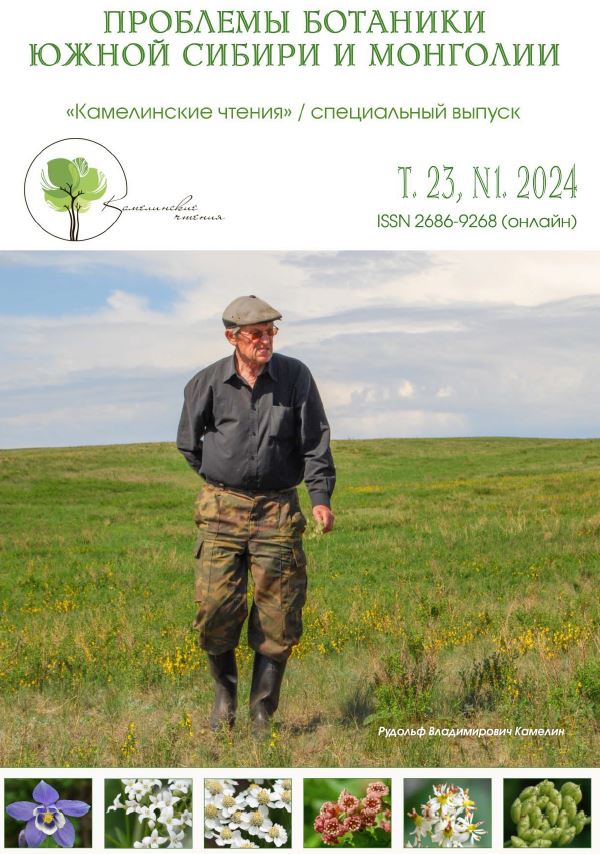The role of the island pine forests of the Russian plain at the southern limit of the range of the Pinus sylvestris in preserving the phytodiversity of the regions of the steppe and forest-steppe zones
УДК 582.475.4:581.93(1-924.85/.86)(47-924.8)
Abstract
Assessment of phytodiversity is carried out on the basis of quantitative parameters of taxonomic units (species, genus, family). This is an important characteristic of natural and administrative territories. Island pine forests are distributed in steppe and forest-steppe zones, where a microclimate different from the surrounding landscapes is formed and reflected in the originality of floras of pine forests. Pine forests were formed as an integral ecosystem, therefore, the plants should be taken into account in floristic summaries of the regions where pine forests are located. The research covered floras of 4 pine forests located in 4 administrative regions: Usmansky pine forest - in Voronezh and Lipetsk, Khrenovskoy - in Voronezh, Buzuluksky - in Orenburg and Samara, Krasnosamarsky - in Samara. Taxonomic units recorded in natural and administrative sites were compared. It was found that the floras of pine forests contain a large proportion of families characteristic of the floras of the regions where pine forests are located (75-79 % on average). The percentage of genera is lower - 60-65 %. The share of species is 41-47 %. The taxonomic structure of pine forests fits into the patterns of spatial distribution of taxonomic richness of the floras of pine forests of Eastern Europe. Usmansky pine forest, located in the forest-steppe zone, is the richest in floristic terms. Island pine forests are characterized by floristic diversity and account for a significant share of taxonomic diversity of the regions.
Downloads
Metrics
References
Бузулукский бор. Общий очерк и лесные культуры / Под ред. В. Г. Нестерова. - М.; Л.: Гослесбумиздат, 1949. -Т. I. - С. 5-13.
Вельмовский П. В., Чибилёв А. А. Проблемы сохранения старовозрастных реликтовых сосняков Бузулукско-го бора в связи с разработкой нефтяных месторождений // Юг России: экология, развитие, 2019. - Т. 14, № 2. -C. 59-69. DOI: 10.18470/1992-1098-2019-2-59-69
Григорьевская А. Я., Прохорова О. В. Сосудистые растения Воронежской области: учебно-справочное пособие. - Воронеж: ВГУ 2006. - 145 с.
Казакова М. В., Ржевуская Н. А., Хлызова Н. Ю., Александрова К. И., Григорьевская А. Я. Флора Липецкой области. - М.: Аргус, 1996. - 352 с.
Кин Н. О. Флора Бузулукского бора (сосудистые растения) // Тр. научного стационара-филиала Института степи УрО РАН «Бузулукский бор». Т. II. - Екатеринбург: УрО РАН, 2009. - 283 с.
Кин Н. О., Стародубцева Е. А. Аннотированный список сосудистых растений Хреновского бора // Тр. Воронежского заповедника. Вып. XXVI. - Воронеж: Биомик Актив, 2012. - С. 64-144.
Корчиков Е. С., Прохорова Н. В., Плаксина Т. И., Матвеев Н. М., Макарова Ю. В., Козлов А. Н. Флористическое разнообразие особо ценного Красносамарского лесного массива Самарской области: I. Сосудистые растения // Самарская Лука: проблемы региональной и глобальной экологии, 2009. - Т. 18, № 3. - С. 187-191.
Мильков Ф. Н. Природные зоны СССР. - М.: Мысль, 1977. - 293 с.
Морозова О. В. Таксономическое богатство флоры Восточной Европы: факторы пространственной дифференциации. Отв. ред. А.А. Тишков; Ин-т географии РАН. - М.: Наука, 2008. - 328 с.
Приказ Департамента природных ресурсов и экологии Воронежской области от 2 июля 2015 г. № 241 «К развитию и размещению планируемых к организации особо охраняемых природных территорий областного значения Воронежской области». URL: http://www.oopt.aari.ru/system/files/documents/departament-prirodnyh-resursov-i-ekologii-Voronezhskoy-oblasti/N241_02-07-2015.pdf
Рябинина 3. Н., Князев М. С. Определитель сосудистых растений Оренбургской области. - М.: Тов-во науч. изд. КМК, 2009. - 758 с.
Саксонов С. В., Сенатор С. А. Путеводитель по Самарской флоре (1851-2011). Флора Волжского бассейна. Т. 1. - Тольятти: Кассандра, 2012. - 512 с.
Черепанов С. К. Сосудистые растения России и сопредельных государств (в пределах бывшего СССР). - СПб.: «Мир и семья-95», 1995. - 991 с.
Серегин А. П. Локальные флоры стоянок зональной практики МГУ: 3. Хреновской бор (Воронежская область); 4 и 5. Дополнения к флорам засек (Тульская область) и Полибино (Липецкая область) // Фиторазнообразие Восточной Европы, 2015. - IX: 2. - С. 45-73.
Стародубцева Е. А. Сосудистые растения. Флора Воронежского заповедника. Сосудистые растения, мохообразные, лишайники, грибы // Флора и фауна заповедников. - М., 1999. - Вып. 78. - С. 5-96.
Чибилёв А. А. Природные условия территории Бузулукского бора // Бузулукский бор: эколого-экономическое обоснование организации национального парка. Т. 1. - Екатеринбург: УрО РАН, 2008. - С. 7-17.
Crichfield W. B., Little Jr. E. L. Geographic distribution of the pines of the world. Washington, DC: U.S. Department of Agriculture, Forest Service, Misc. Publ., 1966. - No. 991. - 64 pp.



